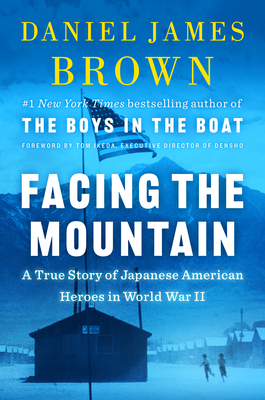
“They couldn’t know that they were about to see things and do things that would change them utterly, things they would regret, things that would sear their souls, and things they would cherish beyond all reckoning. They couldn’t yet understand that they were about to step off the edge of the world.” — Daniel James Brown, Facing the Mountain.
From the author of Boys in the Boat comes another phenomenal read, this one begins as the U.S. enters WWII.
At the time of the Pearl Harbor attack on December 7, 1941, approximately 125,000 Japanese Americans lived on the U.S. Mainland and 200,000 immigrated to the territory of Hawaii. Some were first-generation Japanese Americans, known as Issei, who had emigrated from Japan and were not eligible for U.S. citizenship and 80,000 were second-generation individuals born in the U.S. (Nisei) who were citizens.
On March 18, 1942, the War Relocation Authority began taking people of Japanese descent into custody. It opened ten internment camps in California, Arizona, Wyoming, Colorado, Utah, and Arkansas that held approximately 120,000 Japanese Americans. By 1943, draft-age Nisei lobbied to prove their patriotism and joined an all-Japanese American fighting unit in the U.S. Army.
Facing the Mountain is an unforgettable chronicle of war-time America and the battlefields of Europe. It features four Japanese American families and their sons, who volunteered for the 442nd Regimental Combat Team and are deployed to France, Germany, and Italy, where they accomplished the near impossible.
The 442nd is one of the most decorated units in American history. The press called them “the Purple Heart Battalion” and the Germans nicknamed them “the little iron men” for their courage and fortitude.
This is a fascinating history of Japanese Americans after the attack on Pearl Harbor, loaded with historical tidbits from both the European and Pacific theatres, but the depictions of life in Italy during the war — the hunger, the desperation — are especially disturbing.
The attention to detail is mind-blowing. There is so much history covered, so many battles retold, and the extraordinary photos support the narrative. I’ve read many books about war, but this one really humanized the experience. I wasn’t aware that trench foot (the slow death of nerves and tissues in the feet) was often fatal. “Trench foot often precedes gangrene and was an old, familiar enemy of soldiers everywhere. It had caused an estimated two thousand American and seventy-five thousand British casualties in World War I.”
This is more than a war story. Brown also tells the story of their families living in concentration camps on U.S. soil, the interracial marriage of a young Nisei man and a white pastor’s daughter who stood against the government in defense of his own civil rights.
Facing the Mountain is a heartbreaking picture of what Japanese Americans sacrificed for their country during World War II. The American Constitution, the fundamentals of democracy — personal liberty, equality, free speech — no longer applied to people of Japanese heritage despite the heroism they displayed on the battlefield.
I’d have given this book a five, but there are too many long, convoluted sentences, and too much battle detail. I had to do some skimming. 4.5 stars.
Published Date: May 2021
Genre: Nonfiction
Read-alikes: Honor Before Glory by Scott McGaugh; The Eagles of Heart Mountain by Bradford Pearson; Bridge to the Sun by Bruce Henderson; Just Americans by Robert Asahina.